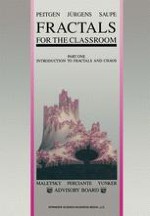1992 | OriginalPaper | Chapter
Encoding Images by Simple Transformations
Authors : Heinz-Otto Peitgen, Hartmut Jürgens, Dietmar Saupe
Published in: Fractals for the Classroom
Publisher: Springer New York
Included in: Professional Book Archive
Activate our intelligent search to find suitable subject content or patents.
Select sections of text to find matching patents with Artificial Intelligence. powered by
Select sections of text to find additional relevant content using AI-assisted search. powered by
So far, we have discussed two extreme ends of fractal geometry. We have explored fractal monsters, such as the Cantor set, the Koch curve, and the Sierpinski gasket; and we have argued that there are many fractals in natural structures and patterns, such as coastlines, blood vessel systems, and cauliflowers. We have discussed the common features, such as self-similarity, scaling properties, and fractal dimensions shared by those natural structures and the monsters; but we have not yet seen that they are close relatives in the sense that maybe a cauliflower is just a ‘mutant’ of a Sierpinski gasket, and a fern is just a Koch curve ‘let loose’. Or phrased as a question, is there a framework in which a natural structure, such as a cauliflower, and an artificial structure, such as a Sierpinski gasket, are just examples of one unifying approach; and if so, what is it? Believe it or not, there is such a theory, and this chapter is devoted to it. It goes back to Mandelbrot’s book, The Fractal Geometry of Nature, and a beautiful paper by the Australian mathematician Hutchinson.2 Barnsley and Berger have extended these ideas and advocated the point of view that they are very promising for the encoding of images.3
